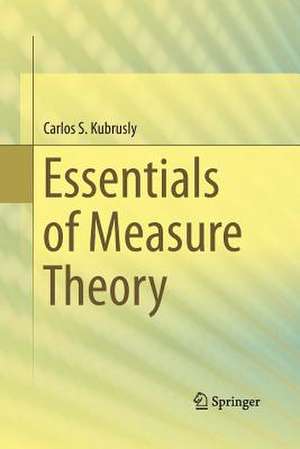Essentials of Measure Theory
Autor Carlos S. Kubruslyen Limba Engleză Paperback – 23 aug 2016
The final section of each chapter in Part I presents problems that are integral to each chapter, the majority of which consist of auxiliary results, extensions of the theory, examples, and counterexamples. Problems which are highly theoretical have accompanying hints. The last section of each chapter of Part II consists of Additional Propositions containing auxiliaryand complementary results. The entire book contains collections of suggested readings at the end of each chapter in order to highlight alternate approaches, proofs, and routes toward additional results.
With modest prerequisites, this text is intended to meet the needs of a contemporary course in measure theory for mathematics students and is also accessible to a wider student audience, namely those in statistics, economics, engineering, and physics. Part I may be also accessible to advanced undergraduates who fulfill the prerequisites which include an introductory course in analysis, linear algebra (Chapter 5 only), and elementary set theory.
| Toate formatele și edițiile | Preț | Express |
|---|---|---|
| Paperback (1) | 421.34 lei 6-8 săpt. | |
| Springer International Publishing – 23 aug 2016 | 421.34 lei 6-8 săpt. | |
| Hardback (1) | 428.30 lei 3-5 săpt. | |
| Springer International Publishing – 18 noi 2015 | 428.30 lei 3-5 săpt. |
Preț: 421.34 lei
Nou
80.63€ • 83.87$ • 66.57£
Carte tipărită la comandă
Livrare economică 14-28 aprilie
Specificații
ISBN-10: 3319372009
Pagini: 279
Ilustrații: XIII, 279 p.
Dimensiuni: 155 x 235 mm
Greutate: 0.42 kg
Ediția:Softcover reprint of the original 1st ed. 2015
Editura: Springer International Publishing
Colecția Springer
Locul publicării:Cham, Switzerland
Cuprins
Recenzii
“The advantage of the book is also that important notions of the theory are considered very carefully and in detail with all sides. It is useful for students.” (Ivan Podvigin, zbMATH 1347.28001, 2016)
Notă biografică
Textul de pe ultima copertă
The final section of each chapter in Part I presents problems that are integral to each chapter, the majority of which consist of auxiliary results, extensions of the theory, examples, and counterexamples. Problems which are highly theoretical have accompanying hints. The last section of each chapter of Part II consists of Additional Propositions containing auxiliaryand complementary results. The entire book contains collections of suggested readings at the end of each chapter in order to highlight alternate approaches, proofs, and routes toward additional results.
With modest prerequisites, this text is intended to meet the needs of a contemporary course in measure theory for mathematics students and is also accessible to a wider student audience, namely those in statistics, economics, engineering, and physics. Part I may be also accessible to advanced undergraduates who fulfill the prerequisites which include an introductory course in analysis, linear algebra (Chapter 5 only), and elementary set theory.
Caracteristici
Descriere
Classical in its approach, this textbook is thoughtfully designed and composed in two parts. Part I is meant for a one-semester beginning graduate course in measure theory, proposing an “abstract” approach to measure and integration, where the classical concrete cases of Lebesgue measure and Lebesgue integral are presented as an important particular case of general theory. Part II of the text is more advanced and is addressed to a more experienced reader. The material is designed to cover another one-semester graduate course subsequent to a first course, dealing with measure and integration in topological spaces.
The final section of each chapter in Part I presents problems that are integral to each chapter, the majority of which consist of auxiliary results, extensions of the theory, examples, and counterexamples. Problems which are highly theoretical have accompanying hints. The last section of each chapter of Part II consists of Additional Propositions containing auxiliary and complementary results. The entire book contains collections of suggested readings at the end of each chapter in order to highlight alternate approaches, proofs, and routes toward additional results.
With modest prerequisites, this text is intended to meet the needs of a contemporary course in measure theory for mathematics students and is also accessible to a wider student audience, namely those in statistics, economics, engineering, and physics. Part I may be also accessible to advanced undergraduates who fulfill the prerequisites which include an introductory course in analysis, linear algebra (Chapter 5 only), and elementary set theory.









